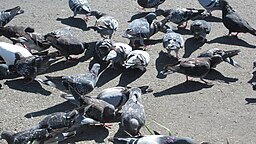
From Barcelona to Bangkok, Dublin to Delhi, Stockholm to Sydney and beyond, the pigeon is a common sight in many towns and cities around the world. Experts reckon that the worldwide feral pigeon population could be as many as 400 million. These canny birds have managed to proliferate on all continents of the world, except Antarctica. Have you ever wondered just how they did it?
Ancient Ancestor
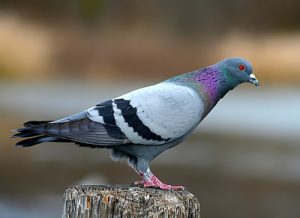
A rock dove. Photo credit: Flickr/CC BY-NC-SA 2.0
It seems almost inconceivable that the feral pigeon’s story starts with the fairly uncommon rock dove. The latter has the familiar look of what many of us would automatically think of as the “pigeon”. That is to say, it has a blue/grey body and two distinctive black bands across its wings. The rock dove just happens to be the world’s oldest domesticated bird and the species from which all feral pigeons are descended.
The wild rock dove’s original range was western and southern Europe, North Africa and some parts of Asia. Its preferred habitat is the relatively remote open countryside, where it can be found nesting at cliff faces, canyons and caves. On the contrary, its descendant, the feral pigeon, thrives in the urban environment throughout the four corners of the globe. Also known as the common pigeon, and mostly as just the “pigeon”, the feral pigeon exists quite comfortably in even the most built-up of areas.
The Messenger
Strong archaeological evidence unearthed in Mesopotamia (modern-day Iraq) suggests that the rock dove was first domesticated as early as the 8th century BC. Initially, it was kept as a ready food source until it was eventually replaced by the chicken. However, the Mesopotamians recognised the rock dove’s unique navigational skills and promoted the wily bird to that of a flying messenger. The rock dove soon proved itself to be indispensable, especially in communications during times of conflict.
Great military leaders such as Hannibal, Julius Caesar and Genghis Khan, all used the messenger pigeon to help outwit their enemies. The domestic pigeon, also known as the homing or carrier pigeon, was also used extensively for messaging during the Great War, and again in World War Two. Even during wartime conditions, it has been estimated that the humble pigeon managed to deliver some 90% of the time, thus saving countless lives. Operated by India’s Orissa police service, the world’s last official pigeon messaging service was not disbanded until 2006.
Rise of the “Feral” Pigeon
Photo credit: Rawpixel/CC0 1.0 DEED
At the beginning of the 17th century, European settlers took the domestic pigeon to the Americas to be used as food and as a messenger. In the early 19th century, the bird’s range was further stretched when colonists took it to Australia. At the same time, the sport of pigeon racing was beginning to emerge in Europe. Owners soon began to cross-breed the rock dove with other pigeon species to produce birds of greater speed and endurance. This inevitably also produced birds with a greater variety of plumage from which the hobby of breeding and “showing” pigeons steadily grew.
Over time, some domesticated pigeons escaped or were purposely released into the wild. This saw the birds not only quickly adjust but positively thrive in the urban environment. Buildings proved to be worthy substitutes for caves and cliffs, which saw the pigeons adopt them as nesting and roosting sites. The birds also proved they could tolerate a variable diet, eating almost any food scraps discarded by humans. With a readily available source of food and shelter, the feral pigeon began to breed all year round.
A 21st-Century Outcast
Feral pigeons, also known as urban, town, city, or street pigeons, are now very much regarded as a pest. Today, many once-large feral pigeon populations have either been eradicated or are strictly controlled. Even at locations where pigeons once wooed tourists e.g. London’s Trafalgar Square, New York’s Washington Square, and Venice’s Piazza San Marco, pigeon numbers have been severely culled.
Fear of feral pigeons as disease carriers, their corrosive droppings and scavenging nature have seen the bird labelled the ‘flying rat’ in recent times. While there is no record of a single case of an infection transfer from pigeon to human, the myth has persisted. Thus, in the 21st century, the feral pigeon is viewed as an outcast pretty much everywhere.
The Amazing Pigeon
From its genesis as a rock dove, the feral pigeon is one of only a few species that has managed to adapt, survive and thrive in a man-built environment. Quite remarkable in itself, here are a few more facts about the amazing pigeon:
- Both male and female pigeons secrete a cottage cheese-like substance from the lining of the crop to feed their offspring. The only other birds that feed their young in this way are the flamingo and the male emperor penguin.
- Scientists are still not sure how it is that the pigeon manages to display such amazing navigational skills. They think the bird uses the sun and the Earth’s magnetic field to navigate on long flights. Near its journey’s end, it is supposed the pigeon uses visual clues and possibly smells, to detect its home loft.
- The feral pigeon’s plumage displays a great array of colours, which includes bronze, red, brown, white, blue, black and grey. The birds also exhibit a variety of wing patterns, including pied, speckled, mottled, barred and chequered. What experts cannot explain is why the feral pigeon has retained such varied colouration. In all similar cases, feral animals have eventually returned to the colours of their wild ancestor.
An Unfortunate Negative
It seems a great irony that the feral pigeon now threatens the very existence of its ancestor; the rock dove. For example, in the UK, almost all rock dove populations are deemed to be interbred with feral pigeons. The only ‘pure’ rock dove populations throughout the British Isles are thought to be on remote Scottish and Irish islands.
Header image credit: Wikimedia Commons/CC BY 3.0 DEED
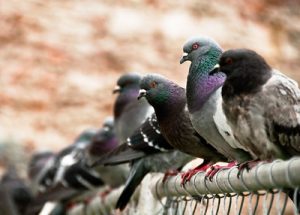

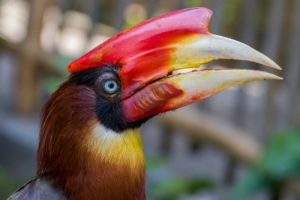


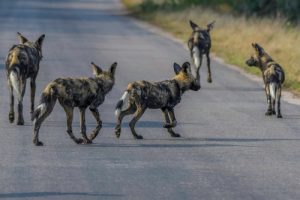
[…] of all birds. Experts believe that the worldwide domestic pigeon population, largely made up of feral birds, could be over 400 […]